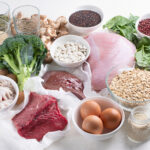It is natural to get bothered about the diabetic diet and nutrition guide when you have a child with juvenile diabetes or type 1 diabetes. While the dietary needs of a child with juvenile diabetes are no different from the normal children, there are some considerations you must follow to ensure the good growth of your child.
In this article, you will know what to eat and what to avoid to keep your child’s blood glucose in range and prevent further health complications.
Children with type 1 diabetes can eat anything but in balance:
People often assume that children with type 1 diabetes can’t take certain foods. It is not true. In fact, there is no food that your children with Juvenile Diabetes can’t eat. He/she can literally eat anything like the rest of your family members.
All you need to take caution about the amount of insulin in his/her foods. Taking insulin in balance helps keep your child’s blood sugar in control and check it to go too high. Making healthy food choices and taking protein, fat, and carbs in balance help keep blood sugar in control for children with type 1 diabetes. So, be sure to make smarter food choices for your children.
Scroll down to understand what types of food and at what amount will help your child stay healthy forever.
Prefer protein-rich foods:
Protein is good for health and helps balance blood glucose. You should choose healthy protein for your child and try to make different dishes from them. Examples of healthful protein foods include:
- Low-fat dairy foods
- Fish
- Eggs
- Lean meat
- Tofu
- Beans and lentils
- Nuts and seeds
Eat plenty of fiber:
Fiber helps minimize the release of sugar in the blood. To ensure enough fiber in your child’s diet, add seeds, nuts, legumes, and beans to their foods. These foods are a good source of fiber as well as contain a high amount of protein. Examples of these foods include:
- Seeds: Pumpkin, hemp, chia, and sunflower seeds.
- Nuts: Brazil nuts, walnuts, hazelnuts, and almonds
- Beans and Legumes: kidney beans, black beans, garbanzo beans, lentils, pintos, and
Add enough non-starchy vegetables to the diabetic diet:
According to American Diabetes Association (ADA), food enriched with the goodness of non-starchy vegetables helps maintain weight, diabetes, and blood pressure. Examples of nonstarchy vegetables include:
- Bell peppers
- Green beans
- Zucchini
- Eggplant
- Mushrooms
- Broccoli and cauliflower
- Green vegetables such as lettuce, cabbage, pak choi, kale, spinach, and watercress
You can add starchy vegetables like corn, potatoes, pumpkin, etc. to the diabetic diet but in smaller amounts, as starchy vegetables contain more sugar.
Count on carbohydrates:
Carbohydrate provides energy to the brain and body required to function their best. Embrace complex carbs such as whole grains and vegetables as they have essential minerals, vitamins, and fiber that help control blood sugar and keep your child healthy. Steer away from refined carbs like white bread and pasta as they can raise blood sugar quickly. Examples of complex carbs include:
- Whole grain pasta
- Whole wheat bread
- Brown rice
- Oats
- Quinoa
- Millet
Have healthful fats:
Make sure to add healthful fat to your child’s diet. It will help them feel fuller for longer and prevent eating too many carbs. Examples of healthful fats include:
- Nuts and seeds
- Olives and olive oil
- Avocados
- Tuna, salmon, and mackerel
Drink plenty of water:
Make sure your child is hydrated all the time by drinking a lot of water. The less water your child drinks, the higher his/her blood sugar will be. Thus, it is vitally crucial for your child with juvenile diabetes to stay hydrated.
While water is the best source of hydration, you can also add citrus fruits, herbal teas, and flavored water to your child’s diet.
What foods to avoid for a child with juvenile diabetes:
Examples of food that your child should avoid taking include:
- Processed foods
- Refined grains
- Sugary cereals
- Fried foods
- Alcoholic beverages
- Soda, cold drinks, and other sugary beverages
- Cakes, candies, biscuits, and pastries
Tips for healthy eating:
Support your child’s daily diet needs by keeping a track of the food chart.
Make a food chart: If you want to keep tabs on your child’s eating pattern and make smart food choices, prepare a food chart.
Keep a food log: Help your child’s dietitian to review his/her eating record by writing down everything about his/her eating habits. From what he/she eats to the amount and number of carbs, jot down everything. It will help your child’s healthcare provider decide whether your child’s meal plan needs some adjustments.
Serve a variety of foods: Don’t be monotonous while preparing the meal plan for your child. Try a variety of foods and go creative. Choose whole grains, lean protein, fresh fruits, vegetables, and healthy fats, and prepare a variety of foods from these options. Visit food recipe blogs and videos for easy ideas. Your child will love it.
Conclusion:
Planning healthy meals can help manage your child’s juvenile diabetes and maintain weight. It may take some time to get used to dietary changes, but starting early will save your child from future health complications. And you will pave a healthy path for your child’s life.
This article gives enough but not complete information on food for children with type 1 diabetes. You should consult a health coach, dietician, or your child’s doctor for more information.



